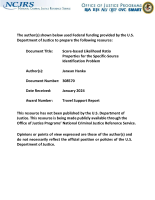Evidence Identification
The New DNA: Recommendations for Agencies to Consider Implementing to Improve Digital Evidence Processing and Analysis
Prosecuting Child Physical Abuse Cases: A Case Study in San Diego
IDENTIFYING HUMAN REMAINS: BLOOD AND DNA TYPING IN BONE
Mock Jurors’ Evaluations of Eyewitness Identification Evidence Based on Appearance Change and Associated Instructions
Score-based Likelihood Ratio Properties for the Specific-Source Identification Problem
A Capillary Electrophoresis Method for Identifying Forensically Relevant Body Fluids Using miRNAs
A Quantitative Method for Determining a Representative Detection Limit of the Forensic Luminol Test for Latent Bloodstains
Balancing the Utility and Legality of Implementing Portable Mass Spectrometers Coupled With Ambient Ionization in Routine Law Enforcement Activities
Detection of Inflicted Bruises by Alternate Light: Results of a Randomized Controlled Trial
Novel Filter Pellet Sample Preparation Strategy for Quantitative LA-ICP-MS Analysis of Filter-Bound Sediments a Green Chemistry Alternative to Sediment Fingerprinting in Tanzania's Ruvu River Basin
The Differentiation of 2,5-Dimethoxy-N-(N-Methoxybenzyl)Phenethylamine (NBOMe) Isomers Using GC Retention Indices and Multivariate Analysis of Ion Abundances in Electron Ionization Mass Spectra
Temperature-Dependent DART-MS Analysis of Sexual Lubricants to Increase Accurate Associations
The Impact of Skin Care Products on Skin Chemistry and Microbiome Dynamics
Application of Self-Organizing Maps to the Analysis of Ignitable Liquid and Substrate Pyrolysis Samples
Effect of Powder Compact Density on the LIBS Analysis of Ni Impurities in Alumina Powders
Characterization of Glitter Cosmetic Particles Using FT-IR Spectroscopy
Estimating the Postmortem Interval Using Microbes: Knowledge Gaps and a Path to Technology Adoption
Universal Detection of Body Fluid Traces In Situ With Raman Hyperspectroscopy for Forensic Purposes: Evaluation of a New Detection Algorithm (HAMAND) Using Semen Samples
A Capillary Eelectrophoresis Method for Identifying Forensically Relevant Body Fluids Using miRNAs
FIU - Forensic Technology Center of Excellence
The Low-Down on Methamphetamine Isomers: Prevalence and Pharmacology in Humans
Can Science Enhance Equity? Findings and Implications From a Study To Detect Bruising on Victims with Dark Skin Pigmentation
This plenary panel from the 2023 NIJ Research Conference features fascinating research on a methodology to improve the detection and documentation of bruises on victims of violence who have dark skin pigmentation. This study highlights the intersection between science, justice, and racial equity, featuring practitioner and victims’ advocacy perspectives. The discussion describes the research and its findings and explore strategies to ensure that this particular evidence-based methodology can be widely implemented by nurse practitioners in the field.
Participants:
See the YouTube Terms of Service and Google Privacy Policy



